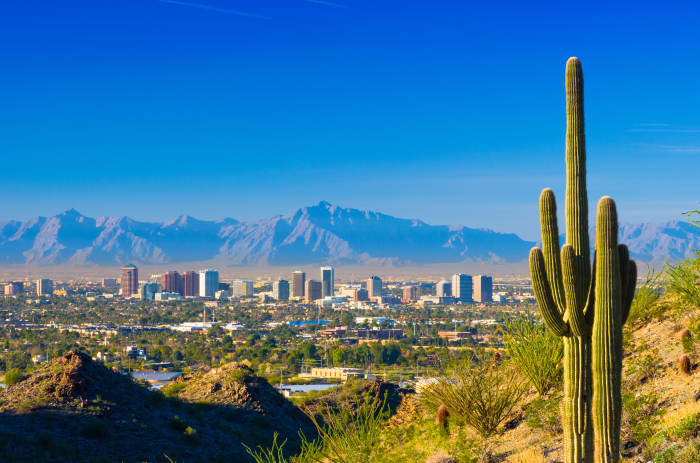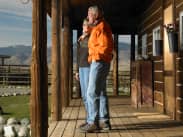I sold my place in Miami Beach some years ago after they raised the street by 3 feet to try to stay ahead of the rising seas.
Most of the scientific forecasts around global warming say that coastal places like southern Florida are going to face real problems from rising sea levels.
Forecasts — of course — have been known to be wrong. But I didn’t feel like gambling on that with a big chunk of money.
It’s one thing to talk about the theory and the future. It’s another to find that your building is now in a dip and the condo association is starting to talk about special assessments.
Which brings me to another traditional destination for retirees — Phoenix.
I wish the local chamber of commerce the best of luck in keeping this city top of mind for future retirees. If this summer’s weather is any guide, they’re going to need it.
Read: It’s official: This summer was the hottest on record
In the 92 days of June, July and August this summer, Phoenix had 82 days when the temperature rose above 100° Fahrenheit (38° Celsius), 51 days when it rose above 110° and 22 days when it rose above 115°. Ouch.
In August the average overnight low was 88° (31° C). In July it was 91°.
It’s one thing to have year-round sunshine. It’s another to be able to fry eggs on the hood of your Chevy three months out of the year.
Yes, Phoenix is always hot in the summer; no, it’s not usually quite like this. The National Weather Service tells me this summer was the hottest on record there. And the five hottest summers ever have all been in the last 10 years — although the one-day record from 1990, 122°, still stands. Twenty years ago the temperature broke 110° half as often as it did this summer.
For generations, U.S. retirees have had a love affair with the region known as the Sunbelt — the warm, balmy South and Southwest. And you can see the appeal: year-round warmth, sunshine instead of sleet in January, as well as cheap land, plenty of space and low taxes.
Read: What climate change? Hot weather is something the top 5 retirement cities have in common.
But is that love affair going to last, if recent weather trends continue?
Naturally, Todd Sanders, the president and chief executive of the Greater Phoenix Chamber of Commerce, says he thinks it will. When I asked him if these types of temperatures were posing a systemic problem for Phoenix, he replied (by email): “No, we are still seeing thousands of retirees moving to Arizona due to our climate, outdoor recreation such as golf, hiking, swimming, biking, pickleball and overall cost of living.”
He also pointed out that Arizona has the advantage of critical mass when it comes to retirees, including hundreds of active-retirement communities, lots of senior-living facilities, and everything from healthcare to dining that is amenable to senior citizens.
We’ll see.
Granted, Phoenix is an extreme case. But other Sunbelt retirement meccas face similar challenges, even if not quite as dire. During June, July and August, for instance, the temperature in Las Vegas topped 100° 53 times. It topped 110° 17 times.
The South and Southwest have been sweltering this summer, and July was the hottest month in recorded history globally. This year is on track to be the hottest year in recorded history, which will mean the past nine years have been the hottest nine in history.
Nothing to see here, folks. Move along.
Some experts are predicting that next year is going to be hotter still.
If this gets any worse, will the next generations of senior citizens want to move to traditional Sunbelt destinations like Florida, Arizona and Nevada?
Really hot weather is dangerous to the elderly, as multiple studies have shown — read about that here, for example, and here and here. One study suggested that once the temperature rises above about 80° (27° C), health risks, especially to people over age 65, start to rise sharply with each additional degree.
And that’s not all. Jesse Keenan, a professor of sustainable real estate and urban planning at Tulane University in New Orleans, made his name a few years back talking about how climate change was likely to change where Americans lived. Actually, he made his name saying Duluth, Minn., would probably be one of the winners. When I called him up to talk about the Fry Belt, he pointed out that these levels of heat also threaten senior citizens indirectly.
For instance, standard medical advice for the elderly is to stay active — to get outside, go for walks, play Pickleball and so on — and to stay socially engaged, meeting up with lots of friends all the time.
Try that at age 80 when it’s 110° outside.
“Heat means people often have to spend a lot of time indoors, and in isolation,” Keenan said.
Meanwhile, the cost of running air conditioning all day and night can put a real strain on the budgets of older people living on fixed or semifixed incomes — especially if the AC is trying to cut the indoor temperature by 35 or 40 degrees.
Keenan reckons U.S. retirees are probably already starting to change their migration patterns. New retirement meccas will emerge. But it will take time before it shows up in the data.
When it does, there will be fortunes to be made — of course. Climate change or no climate change, this is still America.







